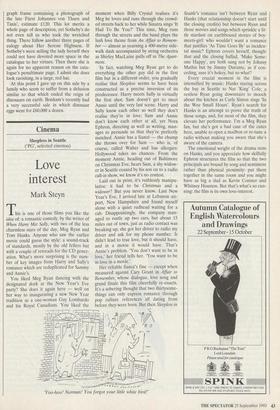Cinema
Sleepless in Seattle (PG', selected cinemas)
Love interest
Mark Steyn
This is one of those films you like the idea of: a romantic comedy, by the writer of When Hany Met Sally, with two of the less charmless stars of the day, Meg Ryan and Tom Hanks. Anyone who saw the earlier movie could guess the style: a sound-track of standards, mostly by the old fellers but with a couple of retreads for the CD gener- ation. What's more surprising is the num- ber of key images from Harry and Sally's romance which are reduplicated for Sammy and Annie's.
You liked Meg Ryan dancing with the designated dork at the New Year's Eve party? She does it again here — well on her way to inaugurating a new New Year tradition as a one-woman Guy Lombardo and his Royal Canadians. You liked the moment when Billy Crystal realises it's Meg he loves and runs through the crowd- ed streets back to her while Sinatra sings 'It Had To Be You?' This time, Meg runs through the streets and the band plays the lush love theme from An Affair to Remem- ber — almost as yearning a 400-metre side- walk dash accompanied by string orchestra as Shirley MacLaine pulls off in The Apart- ment.
In fact, watching Meg Ryan get to do everything the other guy did in the first film but in a different order, you gradually realise that Sleepless seems to have been constructed as a precise inversion of its predecessor. Harry meets Sally in virtually the first shot; Sam doesn't get to meet Annie until the very last scene. Harry and Sally know each other so well they don't realise they're in love; Sam and Annie don't know each other at all, yet Nora Ephron, directing as well as writing, man- ages to persuade us that they're perfectly matched. Annie has a fiancé — the chump she throws over for Sam — who is, of course, called Walter and has allergies: Hollywood takes no chances. From the moment Annie, heading out of Baltimore on Christmas Eve, hears Sam, a shy widow- er in Seattle coaxed by his son on to a radio call-in show, we know it's no contest.
Laid out in print, it's ruthlessly manipu- lative: it had to be Christmas and a widower? But you never know. Last New Year's Eve, I arrived late at Lebanon air- port, New Hampshire and found myself alone with a quiet redhead waiting for a cab. Disappointingly, the company man- aged to rustle up two cars, but about 15 miles out of town, just as radio contact was breaking up, she got her driver to radio my driver and ask for my phone number. It didn't lead to true love, but it should have, and in a movie it would have. That's Annie's problem. 'You don't want to be in love,' her friend tells her. 'You want to be in love in a movie.'
Her reliable fiancé's fine — except when measured against Cary Grant in Affair to Remember, whose dialogue, love song and grand finale this film cheerfully re-enacts. It's a sobering thought that two thirtysome- things can only express romance through pop culture references all dating from before they-were born. But then Sleepless in 'Yoo-hoo! Norman! You forgot your little white bird!' Seattle's romance isn't between Ryan and Hanks (that relationship doesn't start until the closing credits) but between Ryan and those movies and songs which sprinkle a lit- tle stardust on earthbound stories of boy- meets-girl: who wouldn't want a romance that justifies 'As Time Goes By' as inciden- tal music? Ephron covers herself, though: that and the closing ballad, 'Make Some- one Happy', are both sung not by Johnny Mathis but by Jimmy Durante, as if con- ceding, sure it's hokey, but so what?
Every crucial moment in the film is intensified by music: Hanks staring across the bay in Seattle to Nat 'King' Cole; a restless Ryan going downstairs to mooch about the kitchen as Carly Simon sings 'In the Wee Small Hours'. Ryan's search for Hanks is an attempt to prove the truth of those songs, and, for most of the film, they elevate her performance. I'm a Meg Ryan fan, but she's got a bad case of the cutes here, unable to open a mailbox or re-tune a radio without making you aware that she's aware of the camera.
The emotional weight of the drama rests on Hanks, and you appreciate how skilfully Ephron structures the film so that the two principals are bound by song and sentiment rather than physical proximity: put them together in the same room and you might have as big a dud as Kevin Costner and Whitney Houston. But that's what's so cun- ning: the film is its own love-interest.


























































 Previous page
Previous page